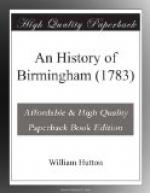Some have asserted, “That property acquired by dishonesty cannot prosper.” But I shall leave the philosopher and the enthusiast to settle that important point, while I go on to observe, That that the lordship of Birmingham did not prosper with the Duke. Though he had, in some degree, the powers of government in his hands, he had also the clamours of the people in his ears. What were his inward feelings, is uncertain at this distance—Fear seems to have prevented him from acknowledging Birmingham for his property. Though he exercised every act of ownership, yet he suffered the fee-simple to rest in the crown, ’till nine years had elapsed, and those clamours subsided, before he ventured to accept the grant, in 1546.
As the execution of this grant was one of the last acts of Henry’s life, we should be apt to suspect the Duke carried it in his pocket ready for signing, but deferred the matter as long as he could with safety, that distance of time might annihilate reflection; and that the King’s death, which happened a few weeks after, might draw the attention of the world too much, by the importance of the event, to regard the Duke’s conduct.
The next six years, which carries us through the reign of Edward the Sixth, is replete with the intrigues of this illustrious knave. He sought connections with the principal families: He sought honours for his own: He procured a match between his son, the Lord Guildford Dudley, and the Lady Jane Gray, daughter of the Duke of Suffolk, and a descendant from Henry the Seventh, with intent of fixing the crown in his family, but failing in the attempt, he brought ruin upon the Suffolk family, and himself to the block, in the first of Queen Mary, 1553.
Though a man be guilty of many atrocious acts that deserve death, yet in the hour of distress humanity demands the tear of compassion; but the case was otherwise at the execution of John, Duke of Northumberland, for a woman near the scaffold held forth a bloody handkerchief and exclaimed, “Behold the blood of the Duke of Somerset, shed by your means, and which cries for vengeance against you.”
Thus Northumberland kept a short and rough possession of glory; thus he fell unlamented; and thus the manor of Birmingham reverted to the crown a second time, the Duke himself having first taught it the way.
Birmingham continued two years in the crown, ’till the third of Queen Mary, when she granted it to
THOMAS MARROW,
1555,
Whose family, for many descents, resided at Berkeswell, in this county.
In the possession of the High Bailiff is a bushel measure, cast in brass, of some value; round which in relief is, SAMUEL MARROW, LORD OF THE MANOR OF BIRMINGHAM, 1664.
The Lordship continued in this family about 191 years, ’till the male line failing, it became the joint property of four coheirs—Ann, married to Sir Arthur Kaye; Mary, the wife of John Knightley, Esq; Ursulla, the wife of Sir Robert Wilmot; and Arabella, unmarried; who, in about 1730, disposed of the private estate in the manor, amounting to about 400_l_. per annum, to Thomas Sherlock, Bishop of London, as before observed, and the manor itself to




